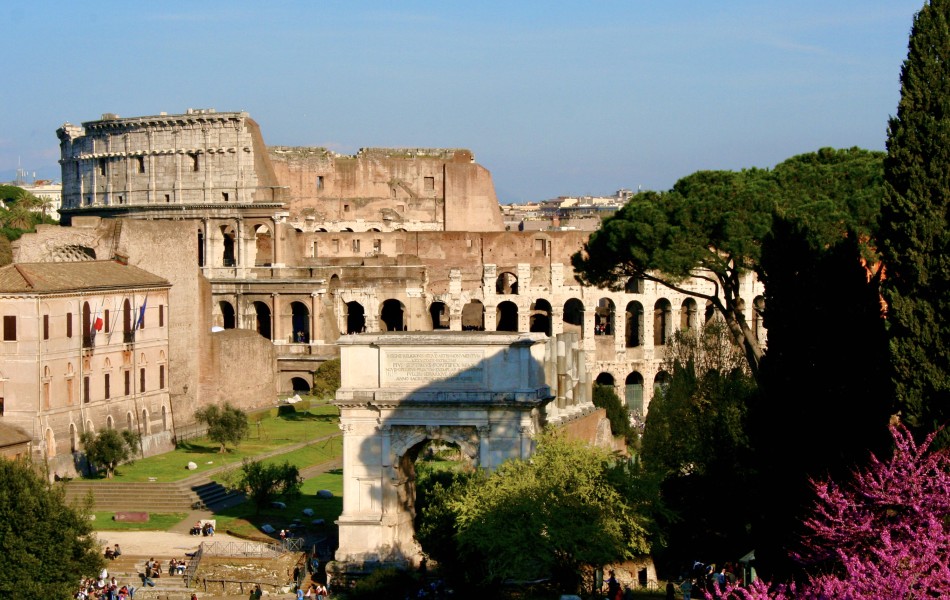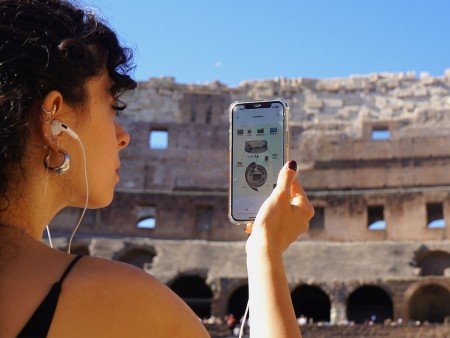All you need to know about the history of the Colosseum
All answers to your questions about the Roman Colosseum: What is it? When was it built and what was it used for? Did they fill it with water?

01 April 2025
Rome Travel GuideThe Colosseum in Rome, also known as the Flavian Amphitheater, is one of the most iconic and best-preserved monuments of the ancient world. Built in the 1st century AD under the emperors Vespasian and Titus, it is the largest amphitheater - the roman architecture used for gladiatorial combats - ever constructed and a masterpiece of Roman engineering. Its elliptical structure, towering arches, and intricate underground hypogeum - a network of tunnels and cages—allowed for the seamless organization of elaborate spectacles. Designed to host gladiator battles, wild animal hunts, and even mock naval battles, these games not only entertained the masses but also reinforced the power and generosity of the emperors. Despite centuries of earthquakes, looting, and natural decay, the Colosseum remains a symbol of Rome’s imperial grandeur and one of the most visited landmarks in the world.
For a complete experience of the Ancient City and Colosseum, including the special sites within the Roman Forum and Palatine Hill, book our visit to the Colosseum Super Sites, accessible with a ticket called "Colosseum Super Sites".
Where is the Colosseum?
The Colosseum is located in the heart of Rome, forming part of one of the largest archaeological areas in the world alongside the Palatine Hill and the Roman Forum. Just a short walk away, the Palatine Hill is one of the most famous of Rome’s seven hills, known as the legendary birthplace of the city and home to the imperial palaces. Next to it, the Roman Forum was the political and commercial hub of ancient Rome, filled with temples, basilicas, and monuments that once defined the empire’s power. Together, these three sites create an open-air museum that stretches across a vast area, allowing visitors to walk through centuries of history in just a few steps.
Beyond the Roman Forum, the Circus Maximus lies nearby, an immense stadium that once hosted chariot races and public games. The Colosseum is also relatively close to the Tiber River, which played a crucial role in the foundation and expansion of Rome. Just a few kilometers away stands the Pantheon, another of the city’s architectural wonders, while to the west, on the other side of the Tiber River, there is the Vatican City, making the Colosseum a key stop for those exploring Rome’s most famous landmarks. The Colosseum is served by a Metro Station and it’s connected to the main centre of Rome, Piazza Venezia, by the famous pedestrian street of Via dei Fori Imperiali, which gives a fantastic view on the archaeological area of the Imperial Fora. It remains a central point for discovering both ancient and modern Rome.
When was the Colosseum built?
The Colosseum was built in the I century AD when Rome was the largest city in the world, with an estimated population of over one million inhabitants, an unprecedented number in the ancient world. The Roman Empire itself was at its height, stretching from Britain to Egypt and from Spain to Mesopotamia, encompassing a population of around 60–70 million people. The Colosseum, as the largest amphitheater ever built, reflected the power, engineering prowess, and cultural influence of Rome. Funded in part by the spoils of the Jewish War (66–73 AD), its construction was a statement of the new dynasty’s strength and commitment to the people, providing them with a massive venue for gladiator games, wild animal hunts, and public spectacles that reinforced Rome’s identity as the center of the known world.
Who built the Colosseum and why?
The Colosseum was built by the Flavian dynasty, initiated by Emperor Vespasian in 70 AD and completed by his son Titus in 80 AD, with further modifications by his younger son Domitian. Vespasian’s rise to power was anything but smooth—he emerged victorious from the Year of the Four Emperors (69 AD), a chaotic period of civil war and political instability following Nero’s suicide. When he secured the throne, the Roman Empire was still recovering from both the Great Fire of 64 AD. To legitimize his rule and distance himself from Nero’s tyranny, Vespasian chose to replace a part of Nero’s private palace with a grand public amphitheater, a powerful symbol of the reconstruction of Rome and a direct gift to the people.
Beyond its architectural and civic importance, the Colosseum served as a tool of imperial propaganda. In a period of great conquests and expansion, the Flavian emperors sought to create a spectacle that would demonstrate their ability to preserve order and stability within the empire. By organizing violent and dramatic games, they showcased their power to control not only the empire’s vast territories but also the very forces of life and death, reinforcing their capacity to maintain dominance and authority over both people and events. The inaugural games, held in 80 AD under Titus, lasted for 100 days and included gladiatorial combats, wild animal hunts, and even naval battles, all staged under the emperor’s supervision. These events were not just entertainment but a carefully orchestrated display of imperial generosity and absolute authority. By offering free, large-scale entertainment, the Colosseum helped cement the Flavian dynasty’s legitimacy and reinforce Rome’s identity as the undisputed center of the known world.
What was the Colosseum used for?
The Colosseum was primarily used for public spectacles, with gladiator contests and other violent games being the most famous. It became one of the most captivating entertainment show in Rome, along with the chariot races held at the Circus Maximus. Gladiatorial combat, where trained fighters engaged in brutal battles to the death, was a central attraction. However, the Colosseum hosted a wide variety of events throughout the day, offering entertainment for the masses. The morning typically began with animal hunts (venationes), where wild beasts such as lions, tigers, and elephants were released into the arena to fight one another or be hunted by trained fighters. These spectacles demonstrated Rome's dominance over nature and its exotic territories. The afternoon was reserved for the most popular and violent events—gladiator games. Gladiators, often slaves or prisoners of war, fought in staged battles, sometimes to the death, for the crowd’s amusement. These matches could be one-on-one duels or large-scale fights with multiple combatants.
How big is the Colosseum?
The Colosseum is the largest arena ever built in ancient Rome and remains one of the most iconic structures in the world. Its architecture is a masterpiece of Roman engineering, featuring a massive elliptical shape that allowed for optimal visibility and crowd control. The outer façade was divided into four levels, each with distinct architectural styles. The first three levels consisted of arched openings framed by engaged columns of different styles, reflecting a hierarchy of elegance. The fourth level, unlike the others, had a solid wall with rectangular windows and Corinthian pilasters, supporting a system of masts and rigging that once held the velarium, a vast retractable awning that provided shade for spectators. Adorning the façade were numerous statues and decorative elements, including colossal figures placed within the arches and intricate friezes that celebrated imperial power and military victories. Though much of this decoration has been lost over time, the grandeur of the Colosseum’s exterior remains awe-inspiring.
The Colosseum could hold an estimated 50,000 to 80,000 spectators, making it the largest amphitheater of the ancient world. Seating was strictly divided according to social hierarchy. The front rows, closest to the action, were reserved for senators, magistrates, and the emperor’s guests, ensuring the elite had the best views. Just above them sat the equestrian class, composed of wealthy citizens and government officials. The next level accommodated ordinary Roman citizens, with further distinctions between the wealthy and the lower classes. At the very top, in a wooden gallery, sat the plebeians, slaves, and foreigners, who had the worst seats but could still witness the thrilling spectacles. Special sections were designated for women, except for the Vestal Virgins, who were given prime seats near the arena. This strict seating arrangement reinforced the rigid social order of Roman society, turning the Colosseum into not just a venue for entertainment, but also a reflection of imperial power and class divisions.
Did they fill the colosseum with water?
The idea that the Colosseum was once filled with water for naval battles, or naumachiae, has long fascinated historians and the public alike. While ancient sources suggest that staged sea battles took place in Rome, the question of whether the Colosseum itself was used for this purpose remains debated. The structure’s early design may have allowed for limited water displays. The logistical challenges of flooding and draining such a massive amphitheater, combined with the later addition of the hypogeum, make it impossible that the Colosseum hosted naumachiae. Instead, its primary function remained that of a gladiatorial arena, a space for wild animal hunts, executions, and dramatic reenactments of famous sea battles. However, some scholars propose that before the hypogeum was built, during the reign of Emperor Domitian, the arena floor could have been temporarily waterproofed and flooded for small-scale naval reenactments. Ancient historian Suetonius mentions that during the Colosseum’s inauguration in 80 AD, various spectacles, including mock sea battles, were held.
Regardless of whether the Colosseum itself hosted naval battles, the Romans were certainly capable of staging elaborate water spectacles. There were specific buildings designed to accommodate large-scale mock sea battles with adequate arenas and artificial basins to be filled with water.
Our categories:
You may also be interested ...

Colosseum Guided Audio Tour with Roman Forum and Palatine Hill
Private tour
Discover Ancient Rome’s secrets and history with our immersive Colosseum guided audio tour, rich in image and content
starting from: € 51 € 42

Domus Aurea Tour with VR Experience: the Architectural Marvel of Imperial Rome
Small group tours
(19)
Step into the vast frescoed halls of Nero’s Domus Aurea, both east and west wings. Enjoy the immersive 3D reconstruction
starting from: € 85 € 61